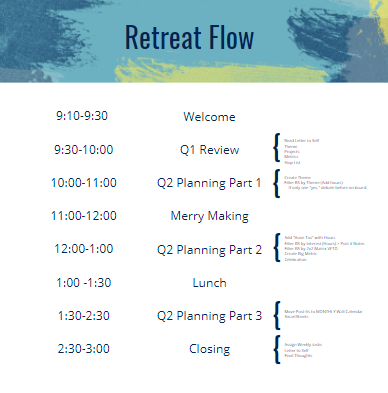If Half Your Team Is Showing Up but Checked Out, You Don’t Have a Performance Problem, You Have an Engagement Crisis
I was talking with a senior leadership team recently who kept asking the same question:
“Why aren’t people going the extra mile anymore?”
They weren’t alone. Across industries, leaders are watching motivation stall. Projects move slower. People aren’t volunteering ideas or an extra helping hand. A few are outright coasting. It’s not that they’ve left the company, it’s that they’re just not really in it anymore. It’s like their badge still works, but their soul has already submitted a two-week notice.
Turns out, they’re part of the growing wave of quiet quitters which is a term Gallup now uses to describe the 50% of U.S. employees who are “not engaged” at work. They’re doing what’s asked, and not a pixel more. Their Outlook is open, their Teams account shows green, but their brain has checked into a hammock. They haven’t quit their jobs officially, but they’ve quit putting in extra effort or enthusiasm.
In Dance Floor Theory, we call this group your Neutrals on the Engagement Pyramid. These are the folks doing the bare minimum: clock in, check boxes, clock out. Technically, they’re doing their job. Emotionally? They’re checked out somewhere between Slack and Spotify. Scoring low on both Competence and Contribution, Neutrals aren’t toxic, they’re just… there. They’re basically an office chair with Wi-Fi access.
Quiet quitting isn’t a Gen Z fad. It’s not about laziness or entitlement.
It’s the symptom of a bigger issue: disengagement is spreading, and leaders need to take it seriously.
The Data Is Clear, and It’s Getting Worse
According to Gallup, U.S. employee engagement has hit a 10-year low.
The percentage of engaged employees has dropped steadily, while the number of actively disengaged workers, what Gallup calls “loud quitters”. has crept up again.
The result? A workplace full of people who are technically present, but emotionally checked out. And that’s not just a morale issue, it’s a $1.9 trillion productivity loss.
Let’s look at the numbers:
- 2020: Engagement peaked at 36%.
- 2022: Dropped to 32%.
- 2023: A tiny rebound to 33%.
- 2024: Down again to 31% which is the lowest in a decade.
Meanwhile, 17% of employees are actively disengaged. Not just bored, but potentially dragging others down.
In DFT language, these are your Negative Nellies, who are people who aren’t just choosing not to engage, but are actively trying to dismantle the culture. And as every leader knows, one Negative Nellie can cancel out a dozen highly engaged team members if left unchecked.
That leaves roughly half the workforce in “not engaged” limbo, which are the quiet quitters, or what we call Neutrals.
Not Just a U.S. Problem
Globally, it’s even worse. Gallup found that only 21% of employees worldwide are engaged, with 77% either quietly or loudly quitting.
The U.S. isn’t alone in this slide, but as one of the historically highest-engagement regions, our drop is particularly alarming.
And remember: every percentage point of engagement equals about 1.6 million U.S. workers. A 5-point drop? That’s roughly 8 million people who’ve stopped caring about their jobs.
In other words, only about one in three employees are genuinely engaged, and everyone else is either coasting or outright miserable.
And unlike “loud quitters” (Gallup’s term for the 15–18% of employees who openly resent their jobs and may actively undermine efforts), quiet quitters don’t usually make a scene. They keep their heads down, do just enough to get by, and often fly under the radar.
But don’t be fooled by their silence, Gallup found that most quiet quitters are already looking for another job. That means disengagement isn’t just a productivity issue, it’s an early warning sign for turnover. By the time someone hands in their resignation, they’ve usually been emotionally gone for months.
The Real Cost of Quiet Quitting: 5 Big Risks for Your Organization
1. Lost Productivity and Performance
Quiet quitting is a slow leak in your performance engine. Gallup estimates disengagement costs U.S. companies up to $1.9 trillion in lost productivity each year. When employees are mentally checked out, they do less, care less, and contribute less. It’s like paying full price for premium gas and watching the tank slowly drip onto the sidewalk.
2. Turnover Risk and Talent Drain
Quiet quitters are often future flight risks. Most are already job hunting in the background, or they will be soon. If half your team is disengaged, that’s half your team with one foot out the door.
3. Damaged Workplace Culture
When disengagement becomes the norm, it reshapes what your culture rewards. Forget extra-mile behavior, just showing up becomes the gold standard. Cynicism spreads. Initiative vanishes. Soon the most ambitious thing someone does is add a new emoji reaction to the all-hands invite.
4. Slowed Innovation and Adaptability
Disengaged teams don’t raise new ideas or solve problems. They follow the script, no more, no less. That’s a major liability in a world that rewards agility.
5. Decline in Organizational Agility and Strategy Execution
Quiet quitters won’t resist change, but they won’t drive it either. This drag on strategic execution makes organizations slow to respond to what’s next.
This Isn’t About Burnout Memes or “Toughen Up” Culture
This isn’t about employees being too soft or needing to “toughen up.” It’s about leaders needing to lead differently.
And it’s about managers doing the daily work to re-engage their people, before quiet quitting turns into actual quitting.
That means:
- Checking in with your managers (who are often disengaged themselves)
- Setting clearer expectations
- Actually listening to what your team needs to stay connected
What Managers Can Do Right Now to Re-Engage Their Team
Here’s how to re-engage the bottom of the Engagement Pyramid:
NEUTRAL – You have to get their attention. You need to create what we call a Blender Event. Blender Events mix up the daily habits of a Neutral. They are designed to inject a jolt of unexpected consciousness into the workplace, disrupting the monotony and sparking curiosity. They’re not about grand gestures or expensive initiatives; they’re about small, unexpected moments that create a positive ripple effect. You don’t need a mariachi band in the break room, just a human moment that makes people pause and go, “Huh, that was cool.”
NEGATIVE NELLIES – They are a different game. In DFT terms: fix or fire. If someone is actively sabotaging the energy of the team, address it directly. Either they shift, or they leave. No amount of motivational posters will reverse a toxic influence.
And across the board, managers can also:
1. Address burnout and well-being
Don’t reward overwork. Prevent it. Make sure workloads are realistic, time off is encouraged, and people aren’t burning out in silence.
2. Connect work to purpose
Help employees see how their role contributes to something bigger. Talk about impact, not just output. Remind them why their work matters.
3. Show appreciation and care
Small, genuine recognition beats big, generic praise every time. Say thank you. Celebrate wins. Acknowledge effort, even when the project falls short.
4. Provide growth and development opportunities
If people feel stuck, they check out. Offer stretch assignments, cross-training, or skill-building opportunities. Show them a path forward.
5. Foster frequent communication and coaching
A weekly 15-minute check-in can prevent months of disengagement. Ask how they’re doing. Ask what’s getting in their way. And actually listen.
6. Set clear expectations and goals
Most quiet quitters don’t start that way, they just get lost. Clarity is key. Make sure every person knows what success looks like in their role.
7. Recognize that management quality matters
You can’t build engaged teams with disengaged managers. Invest in leadership development. Support your managers so they can support others.
Quiet quitting is reversible, but only if managers and leaders step in with clarity, care, and consistency. The work starts at the top, but it lives in the middle.
You can’t fix what you don’t acknowledge. And you definitely can’t solve disengagement with a pizza party. Unless the pizza has healthcare, a sense of purpose, career development, and a weekly one-on-one baked into the crust, it’s probably not gonna cut it.
Engagement isn’t optional. It’s foundational.
So the question isn’t “Are people quiet quitting?” It’s: “What are you doing about it?”




